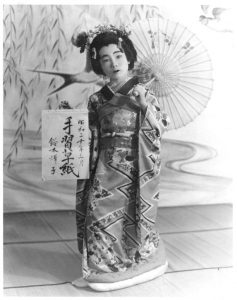Wigged Out
By Margaret Kokka
 Seated backstage with 5 other 10- year old classmates, each of our faces had been whitewashed by Mrs. Sato, our Japanese dance instructor as she prepared us for our recital. I could feel the wet sponge as it covered my cheeks, forehead, chin and my neck. Although none of our families relocated by the US government during WWII was allowed personal cameras, shortwave radios or teaching a Japanese language class, cultural endeavors such as flower arrangements or teaching Japanese odori (formal dance) was permitted.
Seated backstage with 5 other 10- year old classmates, each of our faces had been whitewashed by Mrs. Sato, our Japanese dance instructor as she prepared us for our recital. I could feel the wet sponge as it covered my cheeks, forehead, chin and my neck. Although none of our families relocated by the US government during WWII was allowed personal cameras, shortwave radios or teaching a Japanese language class, cultural endeavors such as flower arrangements or teaching Japanese odori (formal dance) was permitted.
All six of us had spent our hot summer months under Mrs. Sato’s firm tutelage learning to mimic the painstakingly slow movements involved in this ancient art form. She drilled us in the proper opening and folding a multi-hued fan crisscrossed with purple and gold stripes and had us practice flipping and catching the fan on its edge. Applying a steady application under her watchful eyes, we learned to shuffle pigeon-toed as we moved across the stage. Our nearly wordless performance included some high-pitched sing-song words between the performers.
As I sat absolutely still, Mrs. Sato completed applying the ghostly white mask. Next she applied black ink outlining my eyebrows and the outer contours of my eyes. Completing the make-up, a tiny brush filled with clear bright red paint minimized my lips, highlighted my cheeks and dotted the outer corners of my eyes.
Next I was fitted with a tight muslin undershirt. Then I slipped my arms into a cool silky kimono in brilliant oranges, layered with white flowers and vivid green stems covered with swirls of gold and silver streaks. Finally I was nearly jerked off my feet as a heavy brocade belt bound chest high was tightened over my kimono. White-glove like stockings (or tabi) were fitted onto my feet.
Nearly finished, the final touch was fitting a heavy black wig adorned with golden and red combs and silver tassels. Then to my10-year old mind, disaster struck. The heavy, adorned wig did not fit. My thick long hair refused to stay put under the wig and given that no other wig was available, Mrs. Sato informed my mother that my hair would have to be cut.
Once this decision was announced as the solution to this dilemma, I promptly rebelled. I refused adamantly nearly crying, “No, you can’t cut my hair.”
After all the months of preparation where we had studiously trained for this recital, my mother was taken aback by my refusal. After some cajoling and admonishments, Mrs. Sato finally accepted my stance, proceeded to comb and fitted my hair to the rest of the wig, added some trinkets. Making the final adjustment, we entered the stage, danced and adhered to that time honored tradition: “The show must go on.”
![]()

Elusive Time